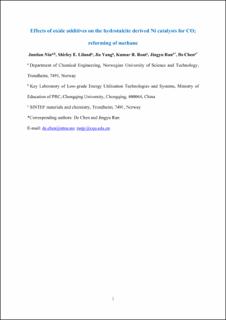| dc.contributor.author | Niu, Juntian | |
| dc.contributor.author | Liland, Shirley Elisabeth | |
| dc.contributor.author | Yang, Jia | |
| dc.contributor.author | Rout, Kumar Ranjan | |
| dc.contributor.author | Ran, Jingyu | |
| dc.contributor.author | Chen, De | |
| dc.date.accessioned | 2020-11-25T08:50:31Z | |
| dc.date.available | 2020-11-25T08:50:31Z | |
| dc.date.created | 2018-10-10T14:06:38Z | |
| dc.date.issued | 2018 | |
| dc.identifier.citation | Chemical Engineering Journal. 2018, 1-12. | en_US |
| dc.identifier.issn | 1385-8947 | |
| dc.identifier.uri | https://hdl.handle.net/11250/2689471 | |
| dc.description.abstract | Here we provide new mechanistic and kinetic insights into the functions of oxides on Ni catalysts in methane dry reforming combining kinetic studies with density functional theory (DFT) calculations. Hydrotalcite derived Ni catalysts with a small amount of oxide additive (CeO2, ZrO2, ZnO) as promoters are synthesized and characterized by different techniques, X-ray diffraction (XRD), X-ray fluorescence (XRF), N2 physisorption, H2 chemisorption, transmission electron microscopy (TEM), scanning electron microscopy (SEM) and thermogravimetric analysis combined with mass spectrometry (TGA-MS). Regarding H2/CO ratio, the CeO2-Ni shows the highest the values along all the temperatures. Moreover, the CeO2-Ni catalyst has the best stability among the four catalysts, while ZnO-Ni experiences the most severe deactivation. Kinetic studies in terms of reaction orders and activation energies are performed and compared to the DFT investigations, to assess the functions of oxide promoters. The CeO2-Ni catalyst shows the lowest apparent activation energy for CO2 activation, and it is also found that forward turnover rate is independent of CO2 partial pressure for all the samples. In DFT calculations, CO2 is more favorable to be activated on the support and the TOF obtained from G plot is in perfect agreement with our experiment value. In addition, it is also found that basicity of oxide additives and electronegativity of metal element can be well correlated to the activation of CO2 and catalyst’s deactivation. In general, both the increased basicity of oxide and the decreased electronegativity of metal element help to promote the CO2 activation and enhance the catalyst’s stability. We propose that the CeO2-Ni catalyst has best performance for CO2 activation, thus leading to a higher surface oxygen concentration to oxidize the carbon on the catalysts, which prolongs the catalyst’s life. | en_US |
| dc.language.iso | eng | en_US |
| dc.publisher | Elsevier | en_US |
| dc.rights | Attribution-NonCommercial-NoDerivatives 4.0 Internasjonal | * |
| dc.rights.uri | http://creativecommons.org/licenses/by-nc-nd/4.0/deed.no | * |
| dc.subject | Basicity | en_US |
| dc.subject | Kinetic study | en_US |
| dc.subject | Catalytic performance | en_US |
| dc.subject | Oxide additive | en_US |
| dc.subject | Methane dry reforming | en_US |
| dc.title | Effect of oxide additives on the hydrotalcite derived Ni catalysts for CO2 reforming of methane | en_US |
| dc.type | Peer reviewed | en_US |
| dc.type | Journal article | en_US |
| dc.description.version | acceptedVersion | en_US |
| dc.rights.holder | © 2018 This is the authors’ accepted and refereed manuscript to the article. This manuscript version is made available under the CC-BY-NC-ND 4.0 license http://creativecommons.org/licenses/by-nc-nd/4.0/ | en_US |
| dc.source.pagenumber | 1-12 | en_US |
| dc.source.volume | 377 | en_US |
| dc.source.journal | Chemical Engineering Journal | en_US |
| dc.identifier.doi | 10.1016/j.cej.2018.08.149 | |
| dc.identifier.cristin | 1619371 | |
| dc.source.articlenumber | 119763 | en_US |
| cristin.unitcode | 7401,80,40,0 | |
| cristin.unitname | Prosessteknologi | |
| cristin.ispublished | true | |
| cristin.fulltext | postprint | |
| cristin.qualitycode | 1 | |

